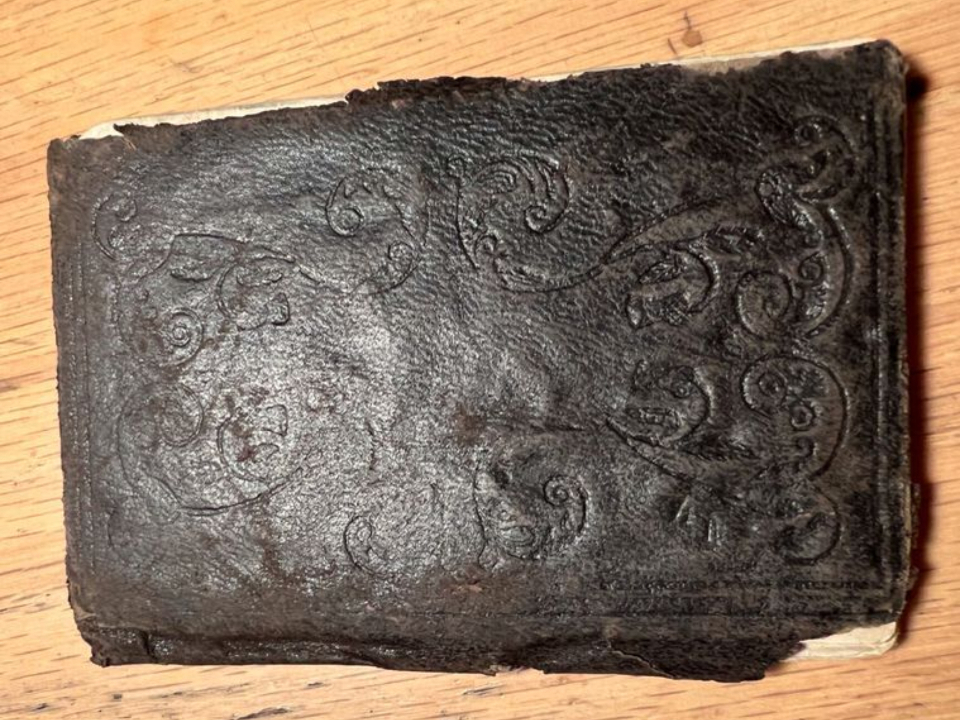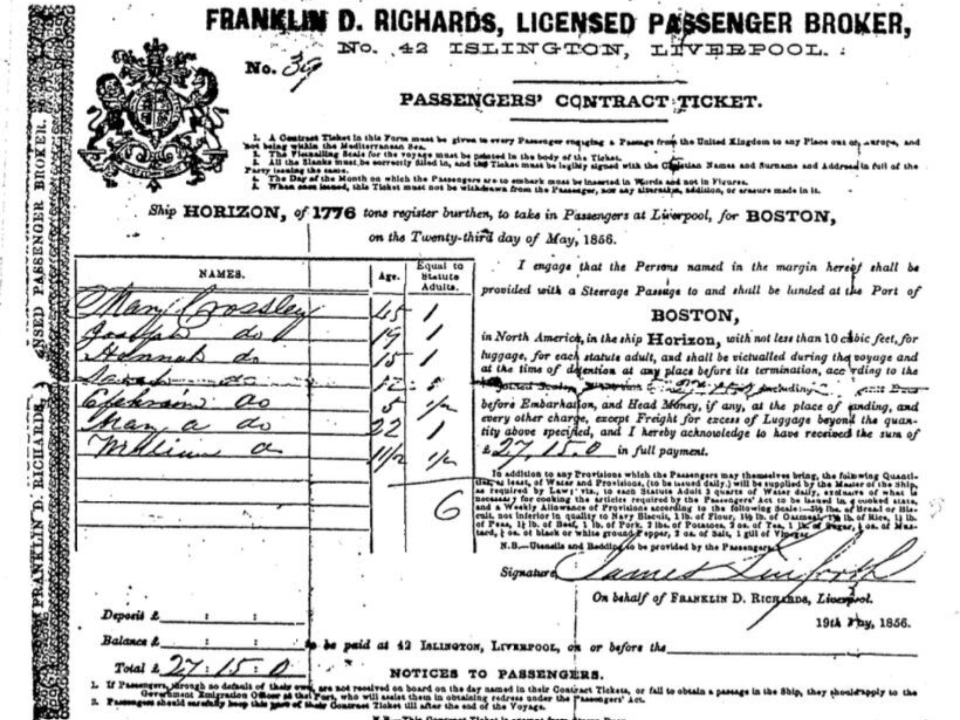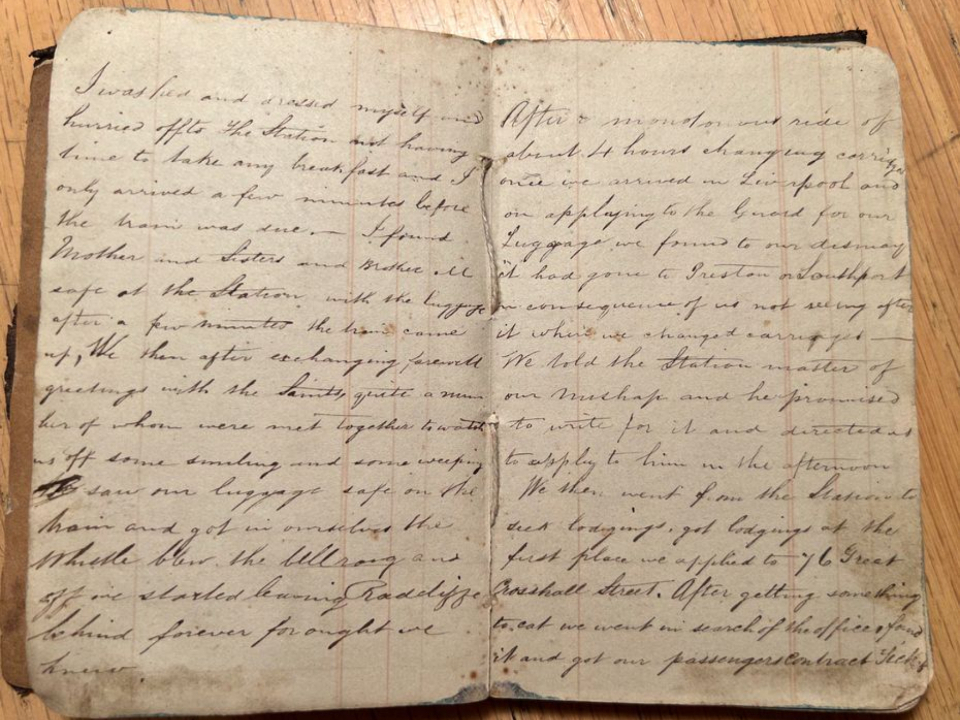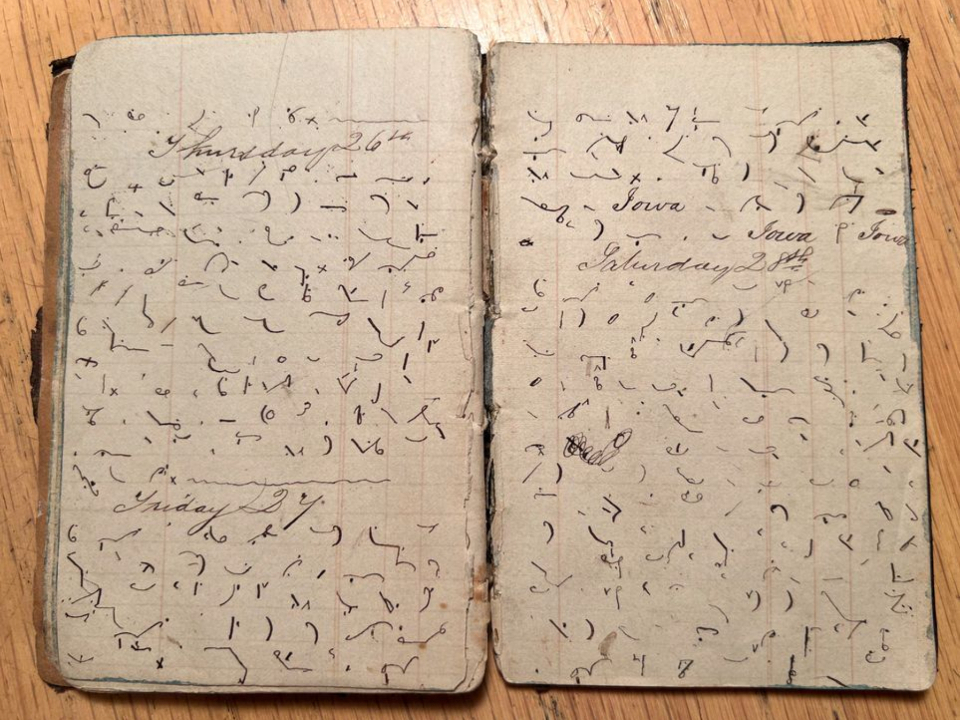
Crossley-journal
The cover of Joseph Crossley’s pocket-sized 1856 journal. The journal was recently donated to the Church History Library. Photo courtesy of Ben Smith, courtesy of Church News.All rights reserved.
This story appears here courtesy of TheChurchNews.com. It is not for use by other media.
By Trent Toone, Church News
Joseph Jarvis Crossley was 19 years old when he and family members boarded the ship Horizon bound for America in May 1856.
Trained as a clerk, Crossley wrote about the monthlong voyage across the Atlantic in a pocket-sized journal, sometimes using shorthand to describe the events and people aboard the ship.
For whatever reason, Crossley stopped writing after he and the other Latter-day Saint passengers disembarked in Boston. Records show his family reached Winter Quarters, Nebraska, then continued across the plains with the ill-fated Martin handcart company. The young man died somewhere near Martin’s Cove in Wyoming.
More than 165 years later, his small journal — passed down through his family and lost for a time — was recently found by descendants and donated on March 1 to the Church History Library of The Church of Jesus Christ of Latter-day Saints.
“It’s pretty old and in pretty bad shape,” said Ben Smith, who participated in the donation. “We gave it to the Church because they can hold on to it better than we can.”

Crossley-journal
A copy of the ticket the Crossley family used on its 1856 voyage aboard the ship Horizon. Photo courtesy of Ben Smith, courtesy of Church News.All rights reserved.
Finding Joseph Crossley’s journal
A century after the voyage, Crossley’s journal was translated from Pitman shorthand to English in Logan, Utah. Pitman shorthand is phonetic system of rapid writing based on the sounds of words rather than on conventional spellings.
A transcript of the journal was circulated, and his story was told at family reunions, which helped keep his memory alive.
The family member who possessed the journal died in 2009, and nobody could find it.
“We thought it was lost,” said Hayden Smith, a family member who participated in the donation.
Nearly 15 years later, the journal was unexpectedly discovered at the bottom of a box in the basement closet of the family member’s Texas home. Many consider finding the journal a miracle.
“Everything just kind of worked out,” said Ben Smith, Hayden’s son. “It very much felt like we were being guided to get this into the right hands.”

crossley-journal
Handwritten pages from Joseph Crossley’s pocket-sized 1856 journal. The journal was recently donated to the Church History Library. Photo courtesy of Ben Smith, courtesy of Church News.All rights reserved.
Informative, Well-written and Intimate
Crossley’s journal is said to be in poor condition with pages almost falling out. It’s a short read, roughly eight pages when typed with spaces between paragraphs.
But the journal is well written and informative. He was the kind of guy a newspaper would hire, said Jeff Anderson, the archivist who received the donation at the Church History Library.
“He writes well, and he’s very literate for a 19-year-old kid,” Anderson said. “In that day, a clerk is a little bit more than just a secretary. ... Their handwriting is at a premium.”
Despite its worn-out condition, Crossely’s journal is one of the best journals of the ocean crossing, said Lyndia Carter, an independent historian who has studied the Martin handcart company and the journal.
“The value I see in it — any historian would — it is one of the very best journals about what everyday life was like on the ocean,” Carter said. “It is also very intimate and personal. ... It is so detailed about how his family is experiencing seasickness; how the daily routine is; how they worship on the ship; and how they live day to day. So it is a valuable journal in the fact that it is so intimate.”
Anyone can read a transcript of the journal on FamilySearch.org.
“There’s a little bit of intrigue in there and a little bit of testimony,” Ben Smith said. “There was a small mutiny when they first got on the ship that was quelled in minutes with new deckhands. ... They were broken in the wards. ... There are some promised blessings on obedience, which was a reoccurring topic. There was smoking below deck, which they weren’t supposed to do. There was a small breakout of measles. I think all the people died and were thrown over board.”

Crossley-journal
Handwritten pages of Pitman shorthand from Joseph Crossley’s pocket-sized 1856 journal. The journal was recently donated to the Church History Library. Photo courtesy of Ben Smith, courtesy of Church News.All rights reserved.
‘You Never Know What Is Out There’
Ken Crossley is another family member who participated in the donation of Joseph Crossley’s journal. He has been intrigued by Joseph Crossley’s story since he first learned about it at a young age.
According to Ken’s research, Joseph Crossley had disability with his leg that perhaps prevented him from working in the mines and led him to be a clerk’s apprentice. As a result, Joseph developed a talent for writing and penned his experience aboard the Horizon, which will allows historians and scholars to learn more about that part of the pioneer journey.
The journal contains the names of many people who others might recognize or discover as their own ancestors.
Ken Crossley also looks forward to seeing high-resolution digital scans of the faded journal pages.
“This will be of special interest to the descendants of all the 1856 pioneer companies,” he said. “You never know what is out there. When you consider family history, I believe the more you give, the more you get.”
Copyright 2023 Deseret News Publishing Company.